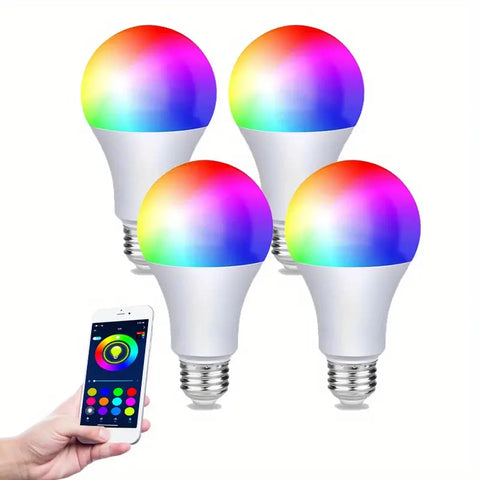Smart LED bulbs have a lifespan of 15,000 to 25,000 hours. Smart bulbs typically last much longer than traditional incandescent bulbs.
This longevity can translate into years of use, depending on how often the bulb is used. For example, a smart light bulb that is used for about 3 hours a day may last about 15 to 20 years. Exact lifespan may vary depending on lamp brand, usage patterns and features.
Factors Affecting the Service Life of Smart Light Bulbs
The service life of smart led lights bulbs will be affected by product quality or environmental use. The following are some factors that affect the life of smart light bulbs:
Switching frequency: Frequently turning your smart bulbs on and off will shorten their lifespan. Every time a light bulb is turned on and off, it causes a momentary voltage surge to the light bulb's electronic components, which gradually affects its performance.
Usage time: The longer the total time a lamp is used, the shorter its remaining life will be. Although the service life of LED light bulbs is much longer than that of traditional light bulbs, continuous use for a long time will gradually consume its life.
Voltage fluctuations: An unstable power supply or frequent voltage fluctuations can cause damage to a smart bulb’s electronic driver, which in turn affects the bulb’s lifespan. High-quality smart light bulbs usually have better voltage regulation and are somewhat resistant to voltage fluctuations.
Heat dissipation design: The heat dissipation effect of LED bulbs directly affects its service life. If a bulb is poorly designed to dissipate heat, overheating may cause damage to internal electronic components, shortening the life of the bulb.
Environmental factors: Ambient temperature and humidity also have a significant impact on the service life of smart light bulbs. High temperature or extremely low temperature environments will accelerate the aging process of LEDs. In addition, high-humidity environments can cause the electronic components inside the bulb to become damp, increasing the risk of failure.
Brand and quality: Different brands of smart light bulbs may vary in build quality and durability. Choosing a reputable and highly rated brand such as Yeelight smart led lights can usually result in longer service life and more stable performance.
Smart Light Bulb Lifespan Example

Understanding the lifespan of smart bulbs across different generations and leading brands can provide valuable insights to consumers looking for long-lasting lighting solutions.
1. First Generation Smart Light Bulb
The first generation of smart light bulbs, such as early models of Philips Hue, introduced consumers to the concept of customizable lighting controlled through a mobile app or smart home system.
With a lifespan of 15,000 to 20,000 hours, these groundbreaking lamps set a new standard for longevity in the lighting industry. Despite their innovative features, first-generation smart bulbs faced some limitations in terms of color accuracy and connectivity range.
2. Second and Third Generation Smart Light Bulbs
Subsequent iterations of smart light bulbs marked significant improvements in functionality and durability. Second- and third-generation smart light bulbs, including products from LIFX and well-known brands like Sengled and Yeelight, demonstrate enhanced color rendering capabilities, improved wireless connectivity, and longer lifespans.
Designed to last between 20,000 and 25,000 hours, these advanced smart bulbs represent continued innovation in solid-state lighting technology. With their exceptional longevity and performance, these next-generation smart bulbs have become a popular choice for modern homes looking for energy-saving and long-lasting lighting solutions.
3. Leading Brands and Their Longevity
Leading manufacturers in the smart lighting industry include longevity as a key feature of their products. Well-known brands such as Philips Hue, LIFX, TP-Link Kasa, Yeelight, and Nanoleaf consistently offer smart light bulbs with a lifespan of 25,000 to 50,000 hours.
These leading brands utilize cutting-edge LED technology and rugged construction to ensure superior durability and reliability in their smart bulbs.
We introduced in detail how smart light bulbs work in our previous article. We hope this article can help you.
How to Extend the Life of Your Smart Light Bulbs

As consumers seek to maximize the life of their smart light bulbs, proper installation and regular maintenance is a must. Follow these basic guidelines to ensure long-lasting use of your smart light bulbs.
1. Install Correctly
The first step to extending the life of your smart light bulbs is ensuring they are installed correctly. When installing smart light bulbs, be sure to do so carefully and avoid subjecting them to undue physical stress. Screwing the bulb securely into the socket gently, without overtightening, will prevent damage to its internal components and extend its life.
2. Environment
Placing your smart bulbs in a well-ventilated area that won't overheat can help extend their durability. Adequate ventilation helps dissipate the heat generated during operation, preventing overheating and potential damage to the electronics inside the bulb.
3. Regular Cleaning
Regular cleaning of the bulb surface with a soft, dry cloth can prevent dust from accumulating, which can impede light output or interfere with heat dissipation. It is important to ensure that the bulb is free of dirt and debris, which may affect its performance over time.
4. Check Electrical Connections
Checking electrical connections and making sure they are tight can help prevent problems like flickering or intermittent operation, which can indicate potential problems with the bulb's lifespan. Promptly addressing any loose connections can reduce wear and tear on the internal components of the bulb and help extend its life.
Additionally, optimizing brightness levels based on specific lighting needs, rather than operating at maximum intensity all the time, helps maintain the overall health of your smart bulbs. By adopting these best usage practices, consumers can effectively extend the life of their smart light bulbs while maintaining consistent lighting quality.
Summary
All in all, smart light bulbs last longer than traditional light bulbs, typically lasting 15,000 to 25,000 hours. This extended service life is affected by a variety of factors, including frequency of use, power supply stability and environmental conditions.
By understanding these factors and making informed choices about smart light bulb brands and usage practices, users can maximize the durability and efficiency of smart lighting, thereby enhancing the functionality and sustainability of their lighting systems.
FAQ
1. What causes smart light bulbs to fail prematurely?
A common cause of premature smart light bulb failure is that excessive voltage fluctuations within the electrical system can put undue stress on the bulb's internal components and cause accelerated wear. At the same time, electrical interference or surges caused by lightning strikes can damage the delicate electronic circuits of smart light bulbs, causing them to fail prematurely.
2. Can the life of a smart light bulb be extended beyond its rated life?
Yes, proper maintenance practices, including regular cleaning and checking electrical connections, can help keep smart light bulbs functional and reduce problems that could shorten their lifespan. Minimizing frequent on and off cycles and using compatible dimmer switches designed for LED lighting can help extend the life of your smart bulbs.
3. How does the lifespan of smart light bulbs compare to traditional light bulbs?
Traditional incandescent light bulbs typically last about 1,000 hours before needing replacement, while compact fluorescent lamps (CFLs) last an average of 8,000-10,000 hours.
In comparison, LED smart bulbs exhibit longer lifespans, with leading brands ranging from 25,000 to 50,000 hours. Not only does it reduce maintenance costs, it also contributes to environmental sustainability by minimizing the waste generated by frequent lamp replacements.


























